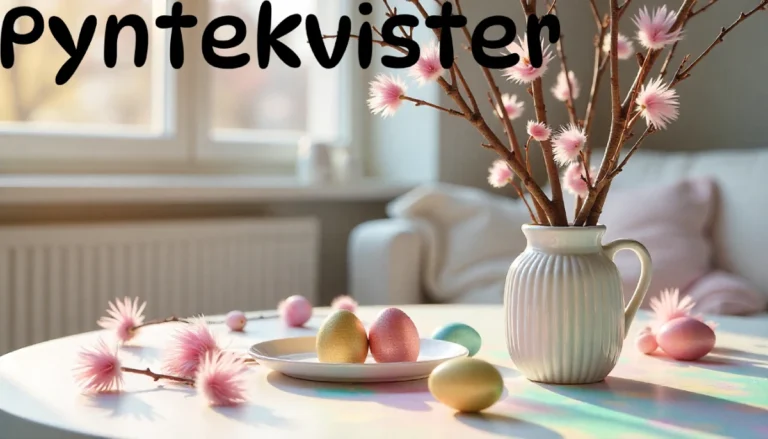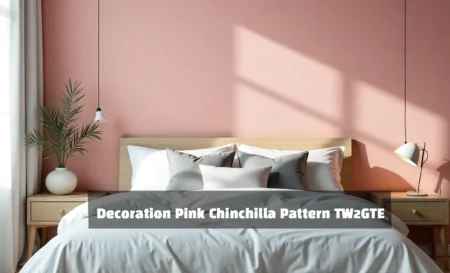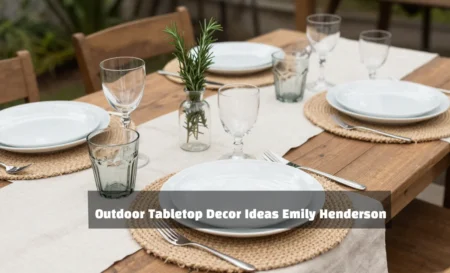Pyntekvister (pronounced “pint-eh-kvis-ter”) are decorative twigs or ornamental branches from Norwegian tradition that bring natural beauty and cultural warmth to modern homes. This sustainable Nordic practice aligns perfectly with today’s biophilic design trends, offering an affordable way to connect with nature indoors while honoring centuries of Scandinavian craftsmanship.
What Are Pyntekvister? Understanding the Nordic Tradition
Pyntekvister, which means “decorative twigs” or “ornamental branches” in Norwegian, adds natural beauty and cultural warmth to homes. This Scandinavian decorative tradition bridges the gap between heritage and modernity, offering a creative way to bring natural elegance into everyday spaces.
Nordic artisans have spent generations picking and arranging twigs and branches to show off their craft skills. These natural pieces mean much more than just looking pretty. The practice represents a deeper philosophy of living in harmony with nature’s seasonal rhythms.
Key characteristics of authentic pyntekvister:
- Natural branches from birch, willow, cherry, or pine trees
- Seasonal adaptability for year-round styling
- Cultural symbolism representing growth, strength, and renewal
The Cultural Significance Behind Pyntekvister
The origins of Pyntekvister lie in Nordic rural traditions: Winter Festivities — Branches adorned with candles and handmade ornaments to bring light during dark months. Spring Celebrations — Budding twigs symbolizing renewal and fertility. Harvest Festivals — Dried twigs used to honor nature’s abundance.
Paganism, as with most ancient religions, was built on the natural world and the cycles it follows. The changing light throughout the year and the importance of agricultural and seasonal markers deeply influenced the emergence of paganism, especially in the Nordic countries.
In some traditions, they symbolize hope and renewal. In others, they represent celebration and togetherness. Moreover, pyntekvister can be personalized, making them meaningful to each family or community.
Why Pyntekvister Are Trending in 2025
The resurgence of pyntekvister reflects broader design movements shaping modern homes. A 2023 report by Global Market Insights forecasts that the global biophilic design market will reach a value of $3.14 billion by 2028, growing at a CAGR of 10.2% from 2023 to 2028.
Americans spend approximately 90% of their time indoors, according to a study conducted by the EPA. This reality drives the need for nature-inspired interior elements that support wellbeing.
Three key trends driving pyntekvister popularity:
Biophilic Design Movement Biophilic design elements play a therapeutic role as they are thought of as calming, uplifting, and anxiety-reducing. Beyond its aesthetic appeal, biophilic design has been proven to enhance mood, elevate productivity, and alleviate stress.
Sustainability Focus
The global home decor market size was valued at USD 747.75 billion in 2024. It is anticipated to grow from USD 802.26 billion in 2025 to USD 1,097.51 billion by 2032. Within this growth, consumers increasingly seek eco-friendly alternatives to synthetic decorations.
Scandinavian Design Appeal One trend in the North American home décor market is the increasing popularity of minimalist and Scandinavian-inspired designs.
Types of Pyntekvister for Every Style
Natural Branch Varieties
Natural pyntekvister stick to tradition. They usually come from birch, willow, cherry, or hazel trees. Each piece stands unique with its authentic textures, special knots, and subtle color changes.
Birch branches offer clean Scandinavian aesthetics with smooth, pale bark that complements minimalist interiors. Willow branches bend easily for dynamic arrangements, while cherry branches provide seasonal blossoms symbolizing renewal.
Modern Adaptations
LED-enhanced branches have gained popularity for winter styling. These LED lighting pyntekvister are used in event decorations and can enhance your events by adding soft texture to your ambience.
Contemporary designers experiment with painted finishes, metallic accents, and integrated lighting to create statement pieces that honor tradition while embracing modern aesthetics.
Creating Your Own Pyntekvister: A Step-by-Step Guide
Materials and Sourcing
Essential supplies: • Fresh or dried branches (birch, willow, or cherry work best) • Clean vases or containers • Optional decorative elements (ribbon, small ornaments, LED lights) • Pruning shears for trimming
Look for fallen branches after storms or during natural pruning seasons instead of buying new materials. This approach saves money and helps the environment.
Basic Arrangement Technique
Step 1: Preparation Clean branches thoroughly and trim to desired lengths. Remove loose bark and dirt.
Step 2: Container Selection Choose vases that complement your space. Tall glass vessels work for dramatic statements, while ceramic bowls suit low, horizontal arrangements.
Step 3: Arrangement In living rooms, create a vertical accent beside a sofa or fireplace to draw the eye upward. Choose tall, sparse arrangements in weighted ceramic vases for stability.
Step 4: Seasonal Enhancement Add elements reflecting current seasons—pussy willows for spring, dried berries for autumn, or small LED lights for winter evenings.
Styling Pyntekvister Throughout Your Home
Living Areas
Place branches at varying heights to create visual layers. Mix textures by pairing smooth ceramic vessels with rough branch bark. Large arrangements serve as focal points, while smaller groupings add subtle natural accents.
Dining Spaces
In dining rooms, keep the profile low so conversation flows across the table; a shallow bowl with short, crisscrossed twigs looks intentionally modern.
Bedrooms and Private Spaces
For bedrooms, one slim branch on a nightstand reads peaceful and is easier to dust than flowers. The simplicity promotes restful environments.
Seasonal Pyntekvister Variations
Winter Displays
Winter — White-painted branches with silver and blue ornaments. On Christmas day, in many Scandinavian communities, particularly in Denmark and Norway, farmers would give their animals extra fodder and take the last sheaf of wheat brought in during the previous harvest and use it to decorate above all the gates and outside doorways on their farm so that the birds might eat it.
Spring Arrangements
Spring — Fresh budding twigs with pastel ribbons. Incorporate early blossoms that symbolize renewal and growth.
Summer and Autumn
Summer — Colorful painted twigs paired with seashells. Autumn — Bare twigs wrapped with golden leaves or dried flowers.
The Wellness Benefits of Pyntekvister
Public health researchers have found that besides reducing stress and improving mood, exposure to nature “contributes to your physical well-being, reducing blood pressure, heart rate, muscle tension, and the production of stress hormones.”
One of the most meaningful aspects of pyntekvister is their ability to mark the passage of time. In a world that often rushes forward, pyntekvister invite us to pause and notice the subtle changes in nature.
Wellness advantages include: • Stress reduction through natural elements • Mindful seasonal awareness • Connection to cultural heritage • Creative expression outlet
Sustainability and Environmental Impact
The use of pyntekvister also carries important environmental benefits. Instead of relying on plastic decorations, natural branches can be used. In fact, they are biodegradable and often collected from existing plants without harm.
Furthermore, they can be reused year after year, and as a result, this practice reduces waste significantly. Moreover, reusing branches each season not only lowers the need for new materials but also encourages mindful living.
The practice aligns with circular economy principles, offering beauty without environmental compromise.
Modern Integration with Interior Design Trends
In 2025, Scandinavian interior design embraces vibrant colour alongside beautiful neutrals. The palette features rich shades of purple, brown, and green, with accents of lime green, lavender, and peach.
Multifunctional furniture remains key in the Scandinavian interior design trends for 2025 as we continue to adapt our homes to ever-changing needs. Pyntekvister complement this versatility by offering decoration that adapts seasonally without requiring storage space.
Care and Maintenance Tips
For fresh branches: • Change water every 3-4 days • Trim stems underwater to prevent air bubbles • Expected lifespan: 1-2 weeks with proper care
For dried arrangements: •
Dust gently with soft brush • Store in dry conditions • Can last months or years with proper handling
Keep your painted branches in dry spots to prevent colors from fading or peeling. Wrap seasonal arrangements in tissue paper before storing them away.
Where to Source and Buy Pyntekvister
DIY Collection: • Local parks (with permission) • Your own garden during pruning • Fallen branches after storms
Commercial Sources: • Florists and garden centers • Online marketplaces • Scandinavian import stores • Craft supply retailers
Quality considerations: • Choose branches with interesting natural shapes • Ensure branches are pest-free • Select appropriate sizes for intended displays
Conclusion: Embracing Timeless Nordic Beauty
Pyntekvister represents more than decorative branches—it embodies a philosophy of living harmoniously with nature’s rhythms. In a world increasingly driven by technology and speed, pyntekvister reminds us of the beauty found in nature’s simplicity — and the joy of bringing that beauty into our daily lives.
As biophilic design continues growing and consumers seek sustainable alternatives to mass-produced decor, this ancient Nordic tradition offers a perfect solution. Whether creating simple seasonal displays or elaborate artistic arrangements, pyntekvister connects us to cultural heritage while enhancing modern living spaces.
The practice encourages mindfulness, celebrates natural beauty, and provides an affordable way to transform any home into a sanctuary that honors both tradition and contemporary wellness values.
FAQ
What does pyntekvister mean?
Pyntekvister means “decorative twigs” or “ornamental branches” in Norwegian, representing a traditional Scandinavian practice of using natural branches for home decoration.
How do you pronounce pyntekvister?
Pyntekvister is pronounced “pint-eh-kvis-ter” with emphasis on the first syllable, following Norwegian phonetic patterns.
What types of branches work best for pyntekvister?
Birch, willow, pine, and blossoming cherry or apple branches are the most common choices because they look elegant and last longer indoors.
How long do pyntekvister arrangements last?
Fresh branches usually last one to two weeks in water, while dried branches can last for months if kept clean and dry.
Can I make pyntekvister with artificial branches?
Yes, artificial branches can create lasting pyntekvister displays, though they lack the authentic cultural connection and environmental benefits of natural materials.





